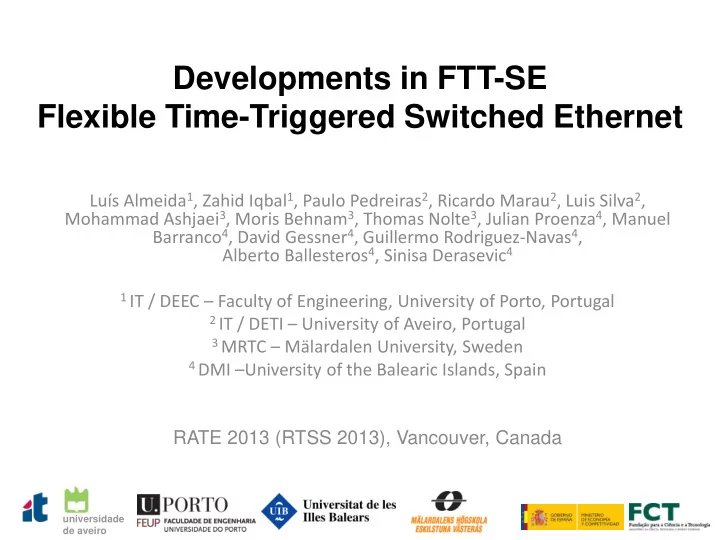

Developments in FTT-SE Flexible Time-Triggered Switched Ethernet Luís Almeida 1 , Zahid Iqbal 1 , Paulo Pedreiras 2 , Ricardo Marau 2 , Luis Silva 2 , Mohammad Ashjaei 3 , Moris Behnam 3 , Thomas Nolte 3 , Julian Proenza 4 , Manuel Barranco 4 , David Gessner 4 , Guillermo Rodriguez-Navas 4 , Alberto Ballesteros 4 , Sinisa Derasevic 4 1 IT / DEEC – Faculty of Engineering, University of Porto, Portugal 2 IT / DETI – University of Aveiro, Portugal 3 MRTC – Mälardalen University, Sweden 4 DMI – University of the Balearic Islands, Spain RATE 2013 (RTSS 2013), Vancouver, Canada universidade de aveiro
Motivation • Open / reconfigurable / adaptive network-centric real-time applications – Multimedia streaming and interactive multimedia, – Flexible cells and industrial multimedia – Reconfigurable vehicles – Data centers and real-time cloud – Flexible/open Cyber-Physical Systems – … • Real-time reconfiguration / adaptation – Maintain real-time guarantees RT-enabled – While cloud • adding / removing data streams • Managing bandwidth
An adequate network abstraction • Dynamic virtual channels – simple composable channel interface • Capacity(B), deadline, period, jitter – can be created / destroyed / adapted • Hierarchical channel composition – channels of channels • Ranges in interface declaration – acceptable vs desireable performance levels
The FTT paradigm • Concentration of operational information – Master node with • System Requirements Data Base master • Online System Scheduler – Consistent and prompt SRDB SS channels management Transmits periodic trigger messages • Emanating triggers to the system with adequate • schedule Isochronous / asynchronous traffic • Any scheduling policy http://www.fe.up.pt/ftt
FTT-SE internals Master schedules traffic per cycles Only traffic that fits in the cycle is scheduled Eliminates memory overflows Supports any scheduling policy FTT master Full priorities Trigger message Deadline-based TM Server-based Ethernet switch … Sig
FTT-SE traffic scheduling Integrated scheduler for all traffic types SRT = {SM i : SM i (C i , D i , T i , O i , Pr i , S i , {R 1i .. R kii }) , i=1..N S } Sync: ART = {AM i : AM i (C i , D i , mit i , Pr i , S i , {R 1i .. R kii }) , i=1..N A } Async: Nodes reaction to the TM in Sync req a given EC Async SM 1 (...) Broadcast to all requests SM 2 (...) l d nodes j l u j ... SM i sched ... Sig M Sig 1 sched TM FP, EDF, ... e M nodes FTT master Switch with M ports M nodes
The HaRTES switch An FTT-enabled switch HaRTES switch • Main features: FTT Master – Same properties as FTT-SE TM plus: Seamless integration of non-FTT nodes Seamless support for real-time channels Traffic polycing Asynchronous traffic managed with hierarchical servers implemented in HW http://www.ieeta.pt/lse/hartes http://serv-cps.av.it.pt /
HaRTES switch internal architecture Admission control NRT packet (Queue) Packet Classifier Invalid QoS Manager Memory pool SRDB Port 1 Up Async. FTT-master Master messages Validate (Queue) Packet FTT packet forwarding Sync. (Queue) NRT Scheduler Memory Input ports Input side Validation data EC Schedule Dispatcher Async Packet Classifier Port 1 Port N Packet list Packet list Port N Up Sync. Syn Asyn NRT Syn Asyn NRT Validate Sync (Queue) FTT packet Async. Port Port (Queue) dispatcher dispatcher Output side Invalid Output ports
Scaling up the network • Multiple switches per master domain (FTT-SE) – Not so efficient because of limited load per cycle
Scaling up the network • Single switch per master domain (FTT-SE / HaRTES) – Interconnection with bridges Manage channels locally Provide channels globally Resource reservation protocol (global channels)
Flexibility and Dependability • The centralized nature of traffic control in the FTT paradigm creates two single points of failure – FTT master – Communication hub/channel • In critical applications this must be solved – Classical approach: replicate both master and hub/channel
Flexibility and Dependability • The on-going FT4FTT-Ethernet project goes beyond and targets all dependability -related vulnerabilities – FTTRS to replicate both FTT master and switch – ReTOPS to ensure consistent multicast transmissions taking advantage of the global view of HaRTES switch – A node replication scheme is being devised based on an enhanced HaRTES switch that restricts node failure semantics • These mechanisms are being designed to work together for significantly increasing the complete system reliability
Examples Heterogeneity Traffic isolation Virtual channels
Examples Reconfiguration C1 H C2 L DH DL C2 H Services C2 implementations L composed online
Examples Openness Adaptation Dynamically reconfigurable virtual channel with definable temporal properties
Examples Dynamically reconfigurable VLAN with definable temporal properties
Examples Openness Integration Dual network stack
Wrapping up • FTT-SE / HaRTES use dynamic resource reservation to partition switched Ethernet networks in a hierarchical and composable way • Provide a channel abstraction that facilitates integration with application models for Cyber-Physical Systems • It is currently probably the only solution for open and adaptive systems with a combination of isochronous/asynchronous traffic How relevant is this ?!
Recommend
More recommend